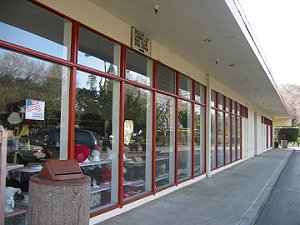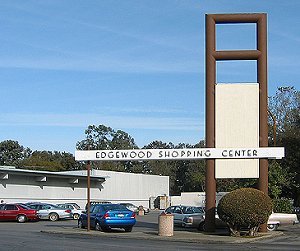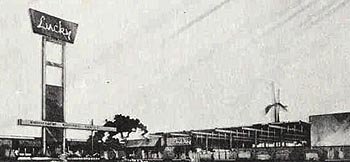 Palo Alto Stanford Heritage
Palo Alto Stanford Heritage Read the article in the September 21, 2012 issue of the Palo Alto Weekly which describes the demolition of one of the two remaining Edgewood Plaza commercial buildings.
Books, that were referenced in the 2008 Holiday House Tour booklet:
Read what Alan Hess has to say about Edgewood Plaza in his article dated Sunday, September 7, 2008.
Could you ever imagine a nationally renowned designer’s buildings being called dilapidated? Would you even think that these buildings, a character–defining feature of a thriving Palo Alto neighborhood, could be on the end of such unsympathetic treatment? Yet, tucked into a corner of Palo Alto, not far from you, there they sit; neglected, quickly gone from spiffy to shabby! And, if nothing is done to reclaim and re–energize them, quickly gone!
Where is this place you ask It is Palo Alto’s Edgewood Plaza, the landmark shopping center created by the legendary Palo Alto-based builder Joseph Eichler to complement the Eichler neighborhood that embraces it. The offices of this visionary builder once looked out over this unique and now threatened resource.
 |
|
Long revered by students of modern architecture, Eichler’s revolutionary use of high quality mid-century architectural concepts in housing accessible to the growing middle class is only now receiving the full appreciation it deserves. Two of the Palo Alto neighborhoods he created have earned a listing on the National Register of Historic Places. One of these, the 1950 Green Gables subdivision, is one block from Edgewood.
Edgewood Plaza was designed to fit seamlessly into that neighborhood and the more recent Eichler developments in the area. Its design and historical significance are nationally recognized; its devotees include the Eichler Network and the Los Angeles Conservancy. It is unthinkable that Palo Alto could lose it or, much much worse, casually waste it. But that could happen.
Showing the effects of years of neglect, Edgewood was a few years ago show-cased as Palo Alto’s first official redevelopment site, and it was duly declared a blighted area for the occasion. However, our city’s enthusiasm wilted when state funding dried up. Next a private developer expressed interest, then quietly faded.
Now a new developer has stepped to the plate. While its detailed plans for Edgewood are still being formulated, the basic recipe is rumored to be a multistory mixture of commercial and housing. How this contemporary mass might fit into Edgewood’s quiet, low-density, single story Eichler neighborhood remains to be seen.
 |
PAST is definitely interested…perhaps you are too. At the October 2002 meeting, the Board of Directors unanimously adopted a resolution endorsing the Edgewood Plaza as a potential historic resource and urging its preservation. That position is itself historic; it is PAST’s first advocacy for a distinctly modern architecture. Edgewood recently passed its 50th anniversary, the threshold for consideration as an historic resource. PAST Heritage believes Edgewood should live to be considered and then hopefully favorably judged |
But, as a practical matter, Edgewood must carry on as a functional retail center to survive. Nobody will afford it as a museum. PAST’s strategy is to advocate revitalizing Edgewood to serve today’s needs in its historic form. We plan to work with the developer, the city, and, most importantly, Edgewood’s neighborhood to find an acceptable, economically viable plan to retain this unique resource in its original architecture and function. Success will be a model victory for realistic preservation. Failure would shame us and our city.
So, to all of you with an interest in tuning-up your advocacy skills (perhaps you even checked “advocating for preservation” on your membership form) this is your opportunity. Would you be willing to attend a meeting or two on Edgewood?
Let’s determine where our efforts could be of most use. Please give it some thought. Help us show that it is possible to imagine how dilapidated buildings might be brought back; that we can promote a revitalized, architecturally intact Edgewood Plaza that could again be an asset to its neighborhood.
 |
A conceptual sketch of Edgewood Plaza |
Note the bold Lucky Super–market's sign, and especially the open ambiance imparted by the store's glass walls.
... one of the "most innovative, best-designed"
shopping centers in the state
E-mail us at either webmaster@pastheritage.org or president@pastheritage.org.
![]() Palo Alto Stanford Heritage—Dedicated to the preservation of Palo Alto's historic buildings.
Palo Alto Stanford Heritage—Dedicated to the preservation of Palo Alto's historic buildings.
Copyright © 2015 Palo Alto Stanford Heritage. All rights reserved.